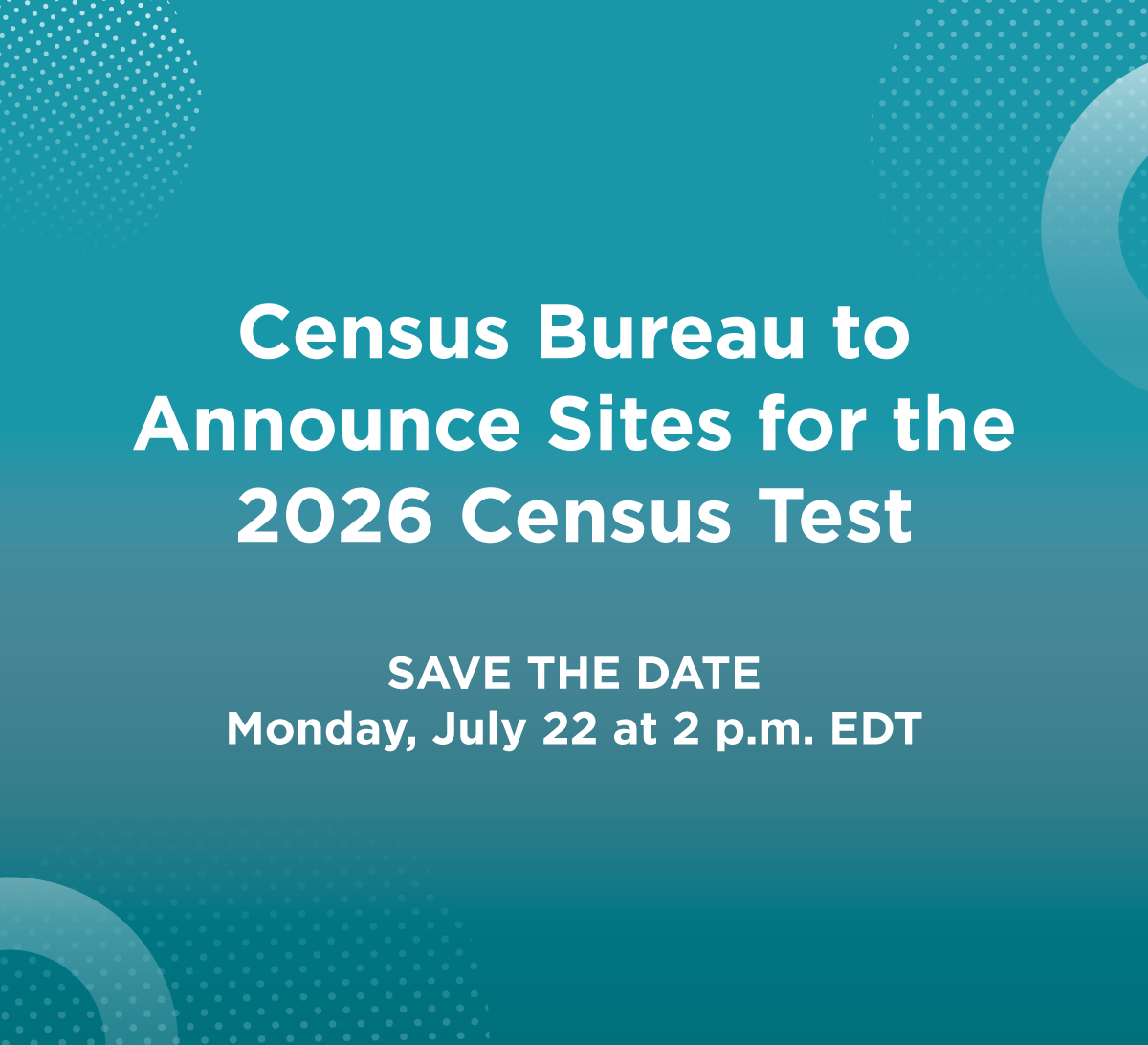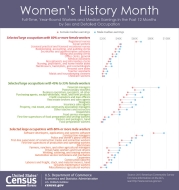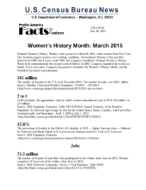Women�s History Month: March 2015
National Women’s History Month’s roots go back to March 8, 1857, when women from New York City factories staged a protest over working conditions. International Women’s Day was first observed in 1909, but it wasn’t until 1981 that Congress established National Women’s History Week to be commemorated the second week of March. In 1987, Congress expanded the week to a month. Every year since, Congress has passed a resolution for Women’s History Month, and the President has issued a proclamation.
Graphic [PDF] <1.0MB
161 million
The number of females in the U.S. as of December 2013. The number of males was 156.1 million. Source: Monthly Postcensal Resident Population: 7/1/2013 – 12/1/2013
<//www.census.gov/popest/data/national/asrh/2012/2012-nat-res.html>
2 to 1
At 85 and older, the approximate ratio by which women outnumbered men in 2013 (4.0 million to 2.0 million).
Source: 2013 Population Estimates, Table PEPAGESEX: Annual Estimates of the Resident Population for Selected Age Groups by Sex for the United States, States, Counties, and Puerto Rico Commonwealth and Municipios: April 1, 2010 to July 1, 2013
<//factfinder.census.gov/bkmk/table/1.0/en/PEP/2013/PEPAGESEX>
52.6%
The percentage of females in the District of Columbia in 2013 — higher than any state — followed by Delaware and Rhode Island at 51.6 percent and Alabama and New York at 51.5 percent.
Source: 2013 Population Estimates
<//www.census.gov/newsroom/archives/2014-pr/cb14-118.html>
Jobs
75.1 million
The number of females 16 and older who participated in the civilian labor force in 2013. Women comprised 47.4 percent of the civilian labor force in 2013.
Source: 2013 American Community Survey 1-Year Estimates, Table DP03
<//factfinder.census.gov/bkmk/table/1.0/en/ACS/13_1YR/DP03>
63%
Percentage of social scientists who were women, the heaviest representation of women among all STEM (science, technology, engineering and math) fields. Among other STEM fields, approximately 14 percent of engineers, 45 percent of mathematicians and statisticians and 47 percent of life scientists were women. The rates of mathematicians and statisticians, and life scientists are not statistically different from each other.
Source: 2012 American Community Survey
<//www.census.gov/newsroom/archives/2014-pr/cb14-130.html>
| Change in Women’s Representation In Select Occupations |
1970 |
2006-2010 |
| Registered nurses | 97.3% | 91.2% |
| Dental assistants | 97.9% | 96.3% |
| Cashiers | 84.2% | 74.7% |
| Elementary and middle school teachers | 83.9% | 79.3% |
| Pharmacists | 12.1% | 52.6% |
| Accountants | 24.6% | 60.0% |
| Computer programmers | 24.2% | 24.4% |
| Physicians and surgeons | 9.7% | 32.4% |
| Lawyers and judges | 4.9% | 33.4% |
| Police officers | 3.7% | 14.8% |
| Civil engineers | 1.3% | 12.7% |
Source: 1970 Equal Employment Opportunity Tabulation based on the decennial census and 2006-2010 Equal Employment Opportunity Tabulation based on the American Community Survey
<//www.census.gov/how/pdf/EEO_infographic.pdf>
13.6
Percent of employed women 16 and over in 2013 (annual average) who worked in management, business and financial related occupations, compared with 15.5 percent of employed men in the same year.
Source: 2013 American Community Survey 1-Year Estimates, Table B24010
<//factfinder.census.gov/bkmk/table/1.0/en/ACS/13_1YR/B24010>
Military
1.6 million
Number of women veterans in the United States in 2013.
Source: 2013 American Community Survey 1-Year Estimates, Table B21001
<//factfinder.census.gov/bkmk/table/1.0/en/ACS/13_1YR/B21001>
Earnings
$39,157
The median annual earnings of women 15 or older who worked year-round, full time in 2013. In comparison, the median annual earnings of men were $50,033.
Source: Income and Poverty in the United States: 2013, Table A-4
<//www.census.gov/content/dam/Census/library/publications/2014/demo/p60-249.pdf>
78¢
The amount that female year-round, full-time workers earned in 2013 for every dollar their male counterparts earned. This ratio was not statistically different from 2012.
Source: Income and Poverty in the United States: 2013, Table A-4
<//www.census.gov/content/dam/Census/library/publications/2014/demo/p60-249.pdf>
Education
10.9 million
Number of women enrolled in undergraduate college and graduate school in fall 2013. Women comprised 56.2 percent of all college students (undergraduate and graduate).
Source: School Enrollment in the United States: 2013, Table 5
<//www.census.gov/hhes/school/data/cps/2013/tables.html>
32.0
Percent of women 25 and older who had obtained a bachelor’s degree or more as of 2014.
Source: Educational Attainment in the United States: 2014, Table 2
<//www.census.gov/hhes/socdemo/education/data/cps/2014/tables.html>
Voting
63.7%
Percentage of female citizens 18 and older who reported voting in the 2012 presidential election. By comparison, 59.7 percent of their male counterparts reported voting.
Source: Voting and Registration in the Election of November 2012, Table 2
<//www.census.gov/hhes/www/socdemo/voting/publications/p20/2012/tables.html>
Motherhood
44.2 million
Estimated number of mothers age 15 to 50 in the U.S. in 2012.
Source: Current Population Survey, 2012, Detailed Table 2
<//www.census.gov/hhes/fertility/data/cps/2012.html>
2.0
Average number of children that women age 40 to 44 had given birth to as of 2012, down from 3.1 children in 1976, the year the Census Bureau first began collecting such data.
Source: Current Population Survey, Historical Table 2
<//www.census.gov/hhes/fertility/data/cps/historical.html>
The percentage of women in this age group who had ever given birth was 85 percent in 2012, down from 90 percent in 1976.
Source: Current Population Survey, Historical Table 2
<//www.census.gov/hhes/fertility/data/cps/historical.html>
Marriage
66.7 million
Number of married women 18 and older (including those who were separated or had an absent spouse) in 2013.
Source: Families and Living Arrangements: 2014, Table A1
<//www.census.gov/hhes/families/files/cps2014/tabA1-all.xls>
5.2 million
Number of stay-at-home mothers nationwide in 2014, compared with 211,000 stay-at-home fathers.
Source: Families and Living Arrangements: 2014, Historical Table SHP-1
<//www.census.gov/hhes/families/files/shp1.xls>
The following is a list of observances typically covered by the Census Bureau’s Facts for Features series:
| Black (African American) History Month (February) Super Bowl Valentine's Day (Feb. 14) Women's History Month (March) Irish-American Heritage Month (March)/ St. Patrick's Day (March 17) Earth Day (April 22) Asian/Pacific American Heritage Month (May) Older Americans Month (May) Mother's Day Hurricane Season Begins (June 1) Father's Day |
The Fourth of July (July 4) Anniversary of Americans With Disabilities Act (July 26) Back to School (August) Labor Day Grandparents Day Hispanic Heritage Month (Sept. 15-Oct. 15) Unmarried and Single Americans Week Halloween (Oct. 31) American Indian/Alaska Native Heritage Month (November) Veterans Day (Nov. 11) Thanksgiving Day The Holiday Season (December) |
Editor’s note: The preceding data were collected from a variety of sources and may be subject to sampling variability and other sources of error. Facts for Features are customarily released about two months before an observance in order to accommodate magazine production timelines. Questions or comments should be directed to the Census Bureau’s Public Information Office: telephone: 301-763-3030; or e-mail: pio@census.gov.








